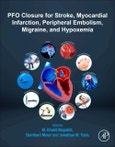Patent Foramen Ovale (PFO) Closure for Stroke, Myocardial Infarction, Peripheral Embolism, Migraine, and Hypoxemia is a complete reference covering the association between PFO and numerous medical conditions. It provides a background on the topic including embryology, anatomy, and physiology. This book fully examines the diagnosis and imaging assessment of PFO and discusses the data linking PFO to various clinical pathologies. It details technical aspects of PFO closure and includes perspectives on future outlooks and where the field is headed in terms of device closure indications. This is a complete reference book for cardiologists, interventional cardiologists, neurologists, pulmonologists, general practitioners, medical professionals, and researchers who are interested in PFO-associated pathologies, technical aspects, safety, and future outlooks of PFO device closure.
Please Note: This is an On Demand product, delivery may take up to 11 working days after payment has been received.
Table of Contents
I. INTRODUCTION 1. Embryology, Anatomy, and Physiology: Anatomical Variations, Lipomatous Hypertrophy, Atrial Septal Aneurysm, Eustachian Valve, Chiari Network, Combination With Other Atrial Septal Defects
II. DIAGNOSIS AND IMAGING ASSESSMENT OF PFO 2. Echocardiography, Transcranial Doppler, and Oximetry for Imaging and Quantification of PFO-Mediated Shunts 3. Angiography, Transthoracic, Transesophageal, and Intracardiac Echocardiography: Periprocedural Assessment and Guidance During PFO Closure
III. STROKE AND PFO 4. Definition of Cryptogenic Stroke, the Risk of Paradoxical Embolism RoPE Score, and Assessment of Embolic Stroke of Undetermined Source 5. Observational Studies of PFO Closure for Stroke 6. Early Randomized Trials of PFO Closure for Stroke (CLOSURE I, PC, RESPECT) 7. Newer Randomized Trials on PFO Closure for Stroke (CLOSE, REDUCE, and DEFENSE-PFO)
IV. NON-CEREBRAL PARADOXICAL EMBOLISM AND PFO 8. Myocardial Infarction and PFO 9. Peripheral Embolism and PFO
V. MIGRAINE AND PFO 10. Migraine Headache: Clinical Association With PFO and Observational Studies 11. Randomized Clinical Trials of PFO Closure for Migraine Headache (MIST, PRIMA, PREMIUM)
VI. OTHER CONDITIONS AND PFO 12. Hypoxemia and PFO 13. Less Recognized Conditions Associated with PFO: Decompression Illness, Carcinoid Heart Disease, Coronary Spasm
VII. SAFETY, TECHNICAL ASPECTS TO PFO CLOSURE, AND FUTURE OUTLOOK 14. Percutaneous PFO Closure: History, Devices, Techniques, Safety, and Informed Consent 15. How I Do It: ICE-guided Technique for Percutaneous PFO Closure 16. How I Do It: Fluoroscopy-guided Technique for Percutaneous PFO Closure 17. PFO Closure: History, Final thoughts and Future outlook 18. The Full Spectrum of PFO: Are We Seeing Just the Tip of the Iceberg? 19. Frequent Questions: PFO Closure With the Amplatzer or Gore Cardioform Devices
Authors
M. Khalid Mojadidi Invasive Cardiologist and Assistant Professor, Division of Cardiology, Virginia Commonwealth University, Richmond, VA, United States. Dr. M. Khalid Mojadidi is an Invasive Cardiologist and Assistant Professor of Medicine at Virginia Commonwealth University. His clinical concentration includes invasive and noninvasive cardiology, echocardiography, and nuclear cardiology. His research interests include PFO and related clinical pathologies. Since early in his career, he has published extensively on different aspects of percutaneous PFO closure for numerous medical conditions. Bernhard Meier Professor of Cardiology, Senior Consultant and Former Chairman of Cardiology, Department of Cardiology, University Hospital of Bern, Switzerland. Bernhard Meier has served from 1992 to his retirement in 2015 as full Professor of Cardiology and Chairman of the Department of Cardiology at the Swiss Cardiovascular Center Bern of the University of Bern, Switzerland. Since 2016, he served as a Senior Consultant. He has personally performed thousands of coronary angioplasties, starting with assisting on the world's first case in 1977, and other catheter-based cardiac procedures. He implanted the world's first dedicated PFO occluder in 1997. Jonathan M. Tobis Division of Cardiology, Department of Medicine,University of California, Los Angeles, Los Angeles,
California, USA. Dr. Jonathan M. Tobis is the Director of Interventional Cardiology Research at UCLA and Clinical Professor of Medicine in Cardiology at the University of California, Los Angeles. He performed the world's first digital left ventricular and coronary angiograms and contributed to the advancements of intravascular ultrasound early in his career. His recent work is devoted to understanding the role of PFO closure in relation to several medical conditions including stroke and migraine. He was voted one of the 10 Most Highly Regarded Heart Doctors in the United States.








